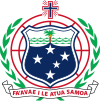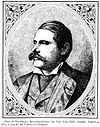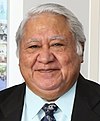Prime Minister of Samoa
| Prime Minister of the Independent State of Samoa | |
|---|---|
| Palemia o le Malo Tuto‘atasi o Sāmoa | |
 | |
 | |
| Ministry of the Prime Minister and Cabinet | |
| Style | Madam Prime Minister (informal) The Honourable (formal) Her Excellency (diplomatic) |
| Type | Head of government |
| Abbreviation | PM |
| Member of | |
| Seat | Apia |
| Nominator | Political parties |
| Appointer | O le Ao o le Malo |
| Term length | Five years, renewable |
| Constituting instrument | Constitution of Samoa |
| Precursor | Leader of Government Business |
| Inaugural holder | Fiamē Mataʻafa Faumuina Mulinuʻu II |
| Formation | 1 October 1959 |
| Deputy | Deputy Prime Minister of Samoa |
| Salary | US$78,000 annually[1] |
| Website | www.samoagovt.ws |
 |
|---|
| Constitution |
The prime minister of the Independent State of Samoa (Samoan: Palemia o le Malo Tuto’atasi o Sāmoa) is the head of government of Samoa. The prime minister is a member of the Legislative Assembly, and is appointed by the O le Ao o le Malo (Head of State) for a five-year term. Since independence in 1962, a total of seven individuals have served as prime minister. The incumbent was disputed due to the 2021 constitutional crisis, when Tuilaʻepa Saʻilele Malielegaoi refused to accept the results of the 2021 general election. On 23 July 2021, the Samoan Court of Appeal ruled that the Faʻatuatua i le Atua Samoa ua Tasi (FAST) party had been in government since 24 May.[2] Tuilaʻepa then conceded defeat, resulting in FAST party leader Fiamē Naomi Mataʻafa becoming prime minister.[3]
History of the office
[edit]Colonial period
[edit]The first prime minister during the colonial period was Albert Barnes Steinberger, who originally represented the American government in the Samoan Islands but was close to German commercial interests. After the indigenous authorities of the islands adopted the Constitution of 1873, Steinberger was appointed prime minister by King Malietoa Laupepa in July 1875. He held this post for seven months before the British and American consuls in the country persuaded Laupepa to dismiss him, seeing his role as German interference in the islands. Over the next two decades, there was no prime minister in the country, and in 1899 Samoa fell under the colonial rule of the Western powers, being divided as a German colony and an American colony at the end of the Second Samoan Civil War, according to the terms of the Tripartite Convention.[4]
At the beginning of the World War I, German Samoa was occupied by New Zealand in 1914, and was subsequently organized as a trust territory of New Zealand in 1920.
Post-independence period
[edit]The position of prime minister replaced the office of the leader of government business in 1959, whilst the country was a territory of New Zealand. High chief Fiamē Mataʻafa Faumuina Mulinuʻu II became Samoa’s first prime minister on 1 October 1959.[5]
After Samoa (then known as Western Samoa) gained independence on 1 January 1962, the prime minister's office remained intact, and the premiership of Fiamē Mata’afa continued.[5] The head of state, or O le Ao o le Malo (initially held by two individuals), was established as a ceremonial office.[6] In 1991, the legislative assembly passed a bill proposed by Prime Minister Tofilau Eti Alesana's Human Rights Protection Party (HRPP) to increase the parliamentary term (and hence the premiership) from three to five years. Which therefore extended the time a prime minister can serve without renewing their mandate.[7]
From 24 May to 23 July 2021, the premiership was in dispute due to an inconclusive result from the 2021 general election and the subsequent constitutional crisis. The claimants were long-serving prime minister Tuila'epa Sa'ilele Malielegaoi of the HRPP, and Fiamē Naomi Mataʻafa of Faʻatuatua i le Atua Samoa ua Tasi (FAST), a former deputy prime minister and daughter of Fiamē Mataʻafa Faumuina Mulinuʻu II. On 23 July, the Supreme Court ruled that Fiamē Naomi’s FAST government was legitimate since 24 May. Tuila'epa conceded defeat on 26 July and ceded power the following day, resulting in Fiamē Naomi Mata‘afa becoming Samoa’s first female prime minister and ending nearly 35 years of HRPP rule.[8][9][10]
Powers and appointment
[edit]The Constitution, adopted in 1960 during the transitional period of autonomy, provides that the executive power is vested in the head of state (O le Ao o le Malo), elected by the Legislative Assembly, and who acts only on the recommendation of the government. The head of state has royal assent powers to sign bills into law and dissolve Parliament. Executive power is exercised by the prime minister and their cabinet. The prime minister is appointed by the head of state as a member of the Legislative Assembly who enjoys the confidence of a majority in the Legislative Assembly (Article 32 (2) (a)). The prime minister may be removed from office by the Legislative Assembly (Article 33 (1) (b)). Samoa is thus a parliamentary democracy based on the Westminster system.[11]
List of officeholders
[edit]- Political parties
- Status
- Symbols
† Died in office
Prime Minister of the Kingdom of Samoa (1875–1876)
[edit]| No. | Portrait | Name (Birth–Death) | Election | Term of office | Political party | Monarch | ||
|---|---|---|---|---|---|---|---|---|
| Took office | Left office | Time in office | ||||||
| 1 |  | Albert Barnes Steinberger (1840–1894) | — | 22 May 1875 | 8 February 1876 | 262 days | Independent | Laupepa |
| Post abolished (8 February 1876 – 1 October 1959) | ||||||||
Prime Ministers of the Independent State of Samoa (1959–present)
[edit]| No. | Portrait | Name (Birth–Death) | Election (Parliament) | Term of office | Political party | O le Ao o le Malo (Head(s) of state) | ||
|---|---|---|---|---|---|---|---|---|
| Took office | Left office | Time in office | ||||||
| 1 |  | Fiamē Mataʻafa Faumuina Mulinuʻu II (1921–1975) | 1961 (1st) 1964 (2nd) 1967 (3rd) | 1 October 1959 | 25 February 1970 | 10 years, 147 days | Independent | Meaʻole & Tanumafili II |
| Tanumafili II | ||||||||
| 2 |  | Tupua Tamasese Lealofi IV (1922–1983) | 1970 (4th) | 25 February 1970 | 20 March 1973 | 3 years, 23 days | Independent | |
| (1) |  | Fiamē Mataʻafa Faumuina Mulinuʻu II (1921–1975) | 1973 (5th) | 20 March 1973 | 20 May 1975[†] | 2 years, 61 days | Independent | |
| — |  | Tupua Tamasese Lealofi IV (1922–1983) Acting prime minister | — (5th) | 21 May 1975 | 24 March 1976 | 308 days | Independent | |
| 3 |  | Tupuola Efi (born 1938) | 1976 (6th) 1979 (7th) | 24 March 1976 | 13 April 1982 | 6 years, 20 days | Independent | |
| 4 |  | Vaʻai Kolone (1911–2001) | 1982 (8th) | 13 April 1982 | 18 September 1982 | 158 days | HRPP | |
| (3) |  | Tupuola Efi (born 1938) | — (8th) | 18 September 1982 | 31 December 1982 | 104 days | Independent | |
| 5 |  | Tofilau Eti Alesana (1924–1999) | — (8th) 1985 (9th) | 31 December 1982 | 30 December 1985 | 2 years, 364 days | HRPP | |
| (4) |  | Vaʻai Kolone (1911–2001) | — (9th) 1988 (10th) | 30 December 1985 | 8 April 1988 | 2 years, 100 days | HRPP | |
| (5) |  | Tofilau Eti Alesana (1924–1999) | — (10th) 1991 (11th) 1996 (12th) | 8 April 1988 | 23 November 1998 | 10 years, 229 days | HRPP | |
| 6 |  | Tuilaʻepa Saʻilele Malielegaoi (born 1945) | — (12th) 2001 (13th) 2006 (14th) 2011 (15th) 2016 (16th) | 23 November 1998 | 24 May 2021 | 22 years, 182 days | HRPP | |
| Tupua Tamasese Efi | ||||||||
| Vaʻaletoʻa Sualauvi II | ||||||||
| 7 |  | Fiamē Naomi Mataʻafa (born 1957) | 2021 (17th) | 24 May 2021 | Incumbent | 3 years, 162 days | FAST | |
Timeline
[edit]
See also
[edit]Notes
[edit]References
[edit]- ^ Hill, Bruce (28 September 2016). "Samoan leaders salaries published by newspaper". ABC Radio Australia.
- ^ "Court declares F.A.S.T. Government; impasse over". Samoa Observer. 23 July 2021. Retrieved 26 July 2021.
- ^ "Tuilaepa concedes, welcomes F.A.S.T. government". Samoa Observer. 26 July 2021. Retrieved 26 July 2021.
- ^ Malama Meleisea, Lagaga: A Short History of Western Samoa, Apia, University of the South Pacific, 1987, ISBN 982-02-0029-6, pp.83-85
- ^ a b Mata'afa, friend to all, who led Samoa 'long and loyally' Pacific Islands Monthly, July 1975, p7
- ^ Hassall, Graham & Saunders, Cheryl (2002). Asia-Pacific Constitutional Systems. Cambridge University Press. p. 41. ISBN 0-521-59129-5.
- ^ So'o, Asofou (2008). Democracy and custom in Sāmoa: an uneasy alliance. University of the South Pacific. p. 171. ISBN 978-982-02-0390-7. Retrieved 7 February 2022.
- ^ Lagipoiva Cherelle Jackson; Kate Lyons (23 July 2021). "Samoa's political crisis ends and first female prime minister installed after court ruling". The Guardian. Archived from the original on 30 January 2022. Retrieved 7 February 2022.
- ^ "Tuilaepa admits defeat after Head of State's declaration". RNZ. 26 July 2021. Archived from the original on 8 December 2021. Retrieved 7 February 2022.
- ^ "Samoa's new cabinet meets to set budget". RNZ. 27 July 2021. Archived from the original on 27 July 2021. Retrieved 7 February 2022.
- ^ Constitution of Samoa


 French
French Deutsch
Deutsch

